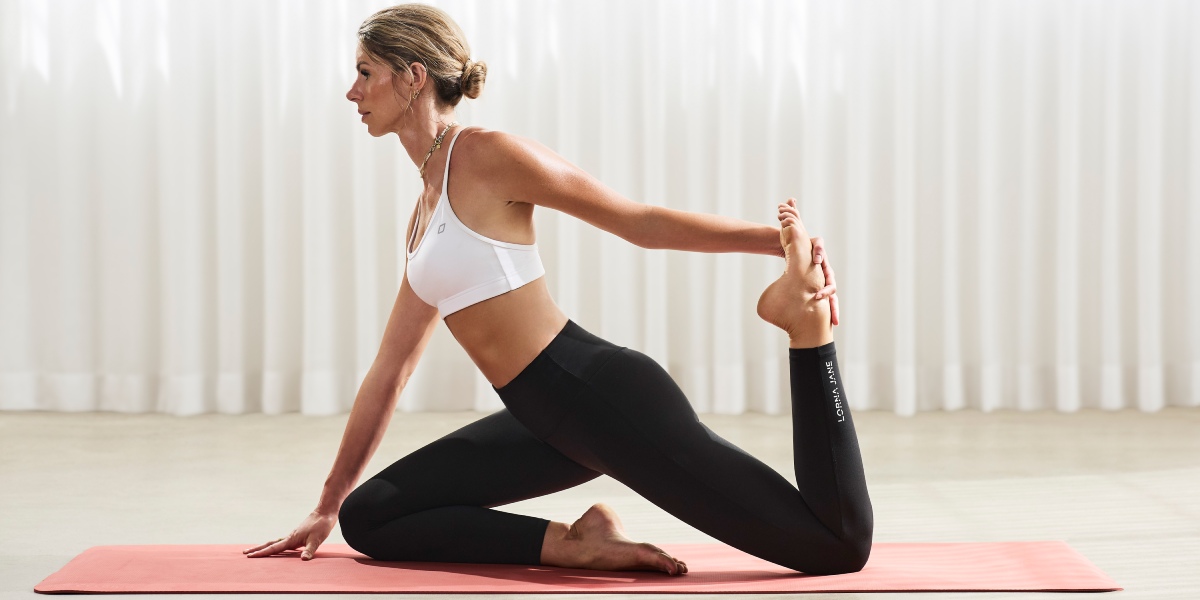If you're new to yoga, you might think all yoga mats are the same. But choosing the right yoga mat is a bit like finding your favourite yoga clothing – comfort, style, and a good fit are key.
When shopping for a yoga mat, you should choose one that feels supportive but doesn't trip you up, looks great but isn't just for show, and can handle your most ambitious poses without falling short.
So, let's dive into how to find your yoga mat soulmate, one that's ready to roll with you through every downward dog and warrior pose.
What is the best thickness for a yoga mat?
When selecting a yoga mat, there's no one size fits all but the style of yoga you practice plays a crucial role in determining the right thickness. For gentler yoga like restorative or yin yoga, a thicker mat provides extra cushioning, making longer holds and restorative poses more comfortable.
On the other hand, if you engage in more dynamic practices such as hatha, power, vinyasa, ashtanga, or hot yoga, a thinner, denser mat (3mm - 4mm thick) is preferable for better stability and balance.
These vigorous styles involve a lot of movement, so a mat with excellent grip and a non-slip surface is essential.
To break it down further:
- Thinner yoga mats are designed for enhanced stability and balance, making them ideal for those seeking a closer connection to the floor.
- Thicker mats, on the other hand, provide extra cushioning and support, making them ideal for floor poses or extended periods of kneeling, sitting or balancing on the forearms. They offer greater comfort and can help reduce strain on the joints, but on the flip side due to their softness, you might find it hard to balance while in some standing poses.
Most standard mats are about 4mm thick, which is a good compromise between comfort and stability, and a good thickness to start with if you're unsure. But if you know you're doing more floor work or are extra sensitive to hard surfaces, consider a thicker mat.

What materials are yoga mats made of?
Yoga mats come in various materials with PVC (polyvinyl chloride), natural rubber, and TPE (thermoplastic elastomer) being the most common. Let's break them down.
- PVC mats are made from a plastic-based material. They also tend to be latex-free, which is great for those who have a latex allergy.
- Natural rubber mats are usually made from tree rubber and free of PVC, phthalates & silicone.
- TPE mats tend to be made from recycled plastic and rubber polymers.
Are grip and traction important?
Imagine trying to do a downward dog on a slip-n-slide. Not ideal, right? We recommend choosing a mat with a good grip to prevent you from slipping and affecting your form.
Mats with textured surfaces or slip-resistant features (like dry grip) are a good idea to help prevent slippage. If you're doing hot yoga, aim for mats designed to handle the heat and sweat (and lots of it). These will include moisture-wicking properties.
What are the different sizes of yoga mats?
Yoga mats come in various sizes (some even 10cm longer than a standard mat length), so make sure it's long and wide enough for your poses but also easy to carry. The standard length of yoga mats we range are approx. 1.8 metres long and 60cm wide.
If you're heading from yoga class to brunch, a mat that rolls up easily and fits in your bag – or has a carry sling – will be a lifesaver. If you're practising at home, you can afford to get a bit more indulgent.
Choose a yoga mat to match your style
At the end of the day, the mat you choose does come down to personal preference that fits your style, supports your practice and doesn't leave you slipping or sliding all over the place. And even though there are many to choose from, most yoga mats will work well for any style of yoga you try.
If you're going to be spending a lot of time looking at this mat, why not pick one that makes you smile? Whether it's a bold colour or a funky pattern, choose a mat that makes you happy to roll out and get to work.
How do you clean a yoga mat?
Your yoga mat can be a bit like a sponge – soaking up sweat, dust, and the occasional rogue snack crumb from that post-practice bite. But let's not wait until it starts to resemble a science experiment.
Regularly cleaning your mat not only keeps it from becoming a breeding ground for germs but will also help with the longevity of your mat.
So grab that spray bottle and let's give your mat the spa treatment it deserves, you'll also find a DIY Yoga Mat Cleaning Spray idea in here too.
Ready to Shop?
Check out our entire range of Yoga and Pilates mats or head in-store and speak to one of our friendly rebel staff to find the right mat for you.